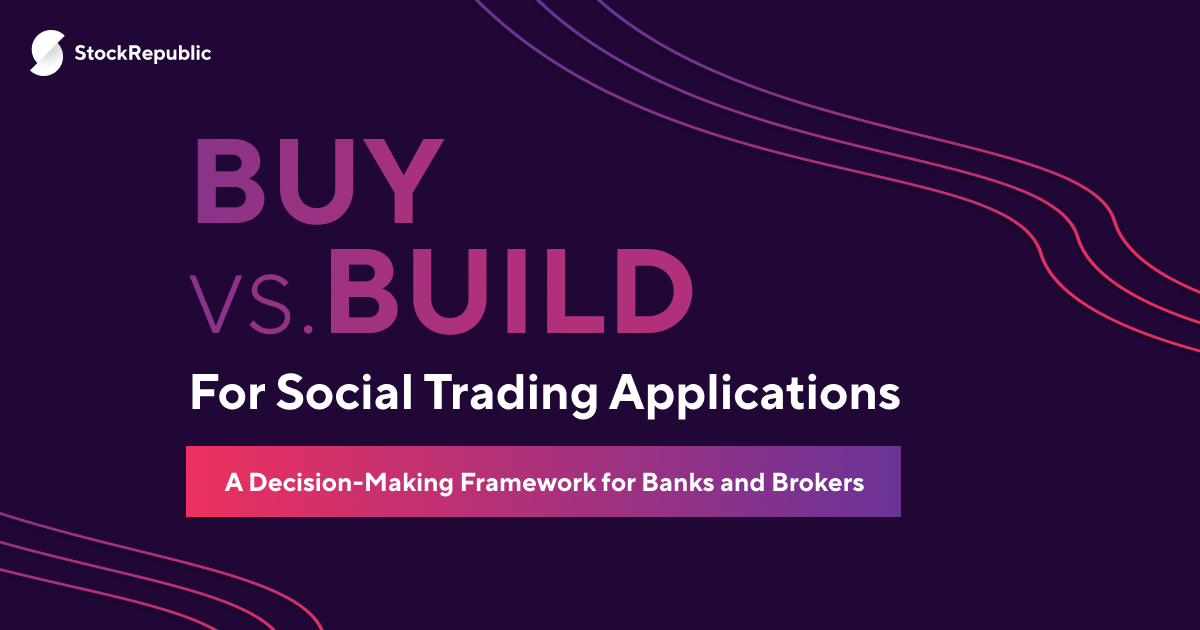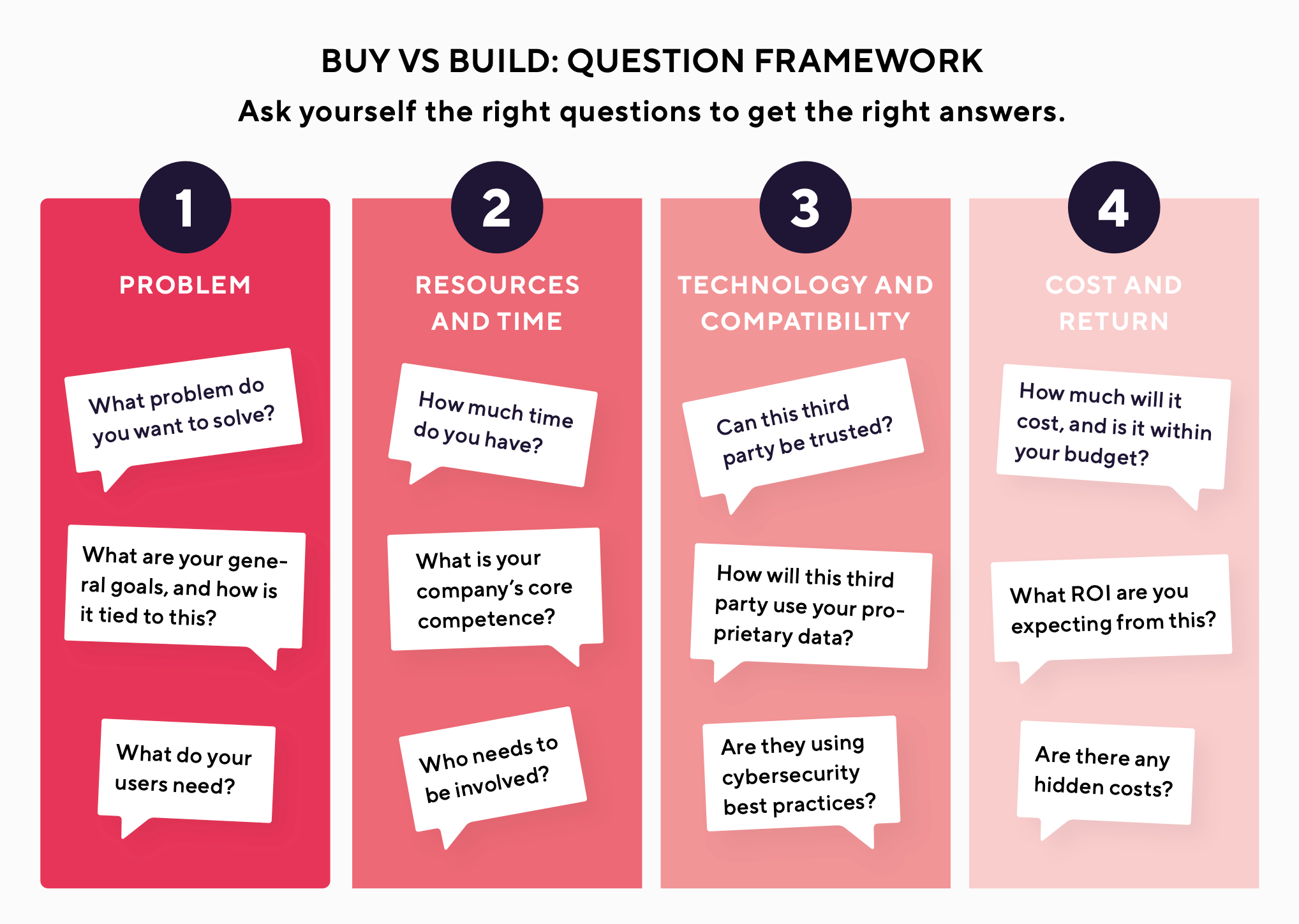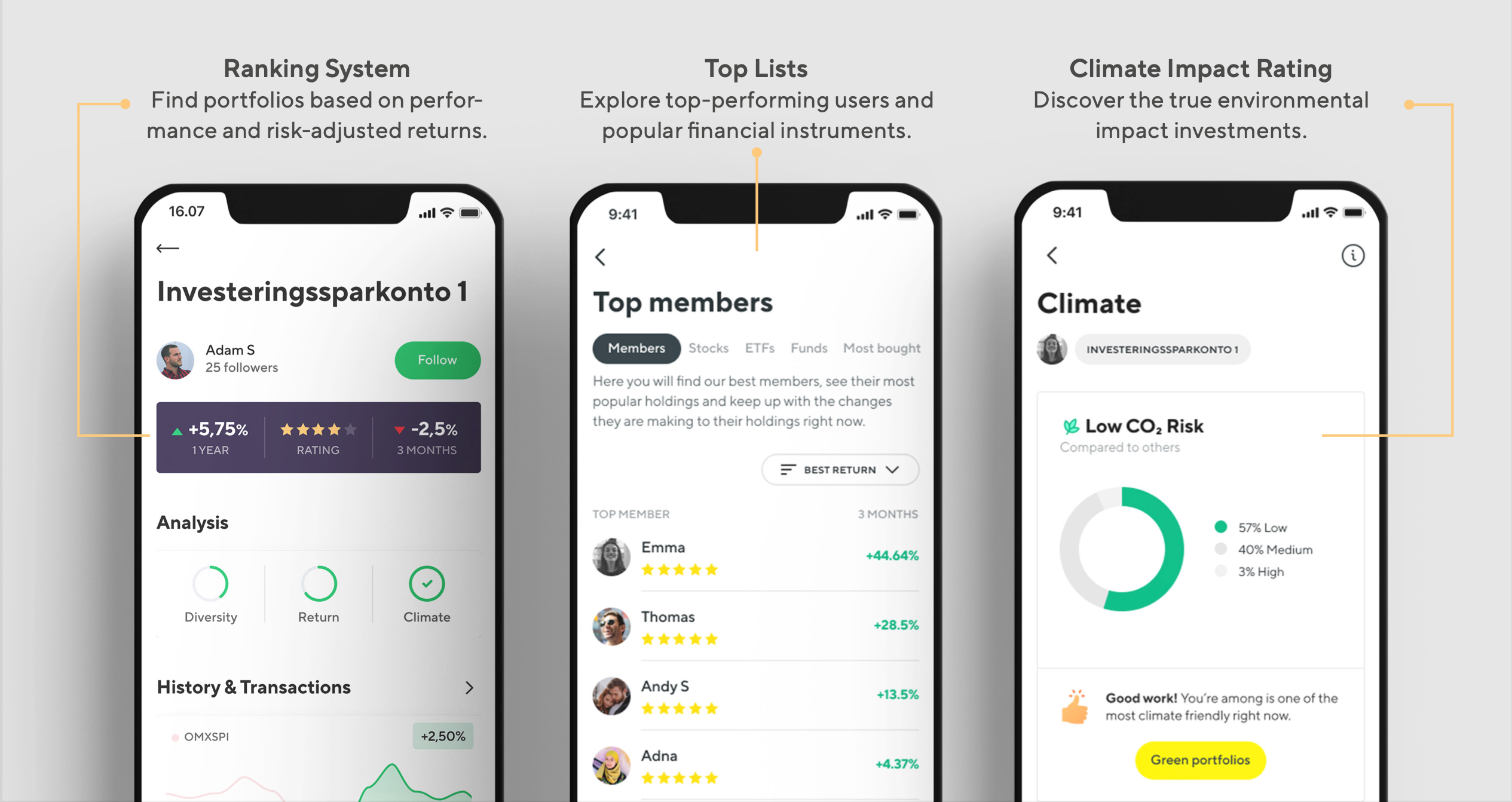
A Plan for a Problem
The decision to build or buy typically stems from a desire to solve a specific company or customer problem. To begin solving your problem at hand, it’s helpful to ask yourself, team members, and key stakeholders some essential questions. While there is no one-size-fits-all solution, the information in this resource will give you the tools to create an outcome-based plan. Regardless of the scenario you choose, StockRepublic can help you.

1. Resources & Time
Will your organization have the right amount of time, dedication, and people with the right skills to build and maintain a social trading app from scratch, or are your resources in better use elsewhere? Before deciding whether to build or buy, you must map out your resources.
What are the core competencies of your company? Does your company have the skills, tech, or experience to solve the identified problem in-house or not? To build, launch, and maintain a social trading platform from scratch requires a broader team of backend- and frontend developers, application designers, UX writers, product marketers, growth managers, and community managers.
If you’ve done the calculation work and are leaning towards building your solution, it’s essential to consider the resources used and how that impacts other areas of your business. For example, the opportunity cost of using your resources to build social trading functionality if they’re needed elsewhere may hurt your core business. If social trading is not (or will not be) your main product, it makes sense to outsource it.
How much time do you have? Is your problem a threat to the very livelihood of your company or just a nagging annoyance that could be improved? If you need a solution right now or would like to utilize a first-mover advantage, it’s an easy decision - buy it! Here’s a helpful scenario to consider: You recently noticed an alarming increase in churn rates – the retail investors of your banks are joining other neo-banks or zero-fee brokers because your platform doesn’t offer functionality that engages and educates them. In this case, the quicker you can deliver a product and start delivering value, the more of a competitive advantage your company will have over time.
If the current problem, however, isn’t threatening the health of your business short term, then there may be room to build your own social trading software. And hey, you don’t need to start entirely from scratch – you can always utilize our social trading API.
Who will support and moderate the new feature? When building social trading apps, remember that the job continues after launch. Not only do you need to focus on product development and maintenance, but you will also need customer support and moderation when you launch a new social trading application or feature set. According to Hubspot, 58% of customers consider switching to a competitor directly due to poor customer service. If your customers can’t access the support they need or feel that they’re heard, it won’t matter how impressive your solution is.
Questions to ask
- What current skills exist in your company?
- If your problem is not solved soon, will it critically impact the health of your business?
- Are you taking the money and personnel away from meaningful work elsewhere?
2. Technology & Compatibility
Even though social trading is an excellent way of differentiating yourself, increasing engagement, or branding yourself as a community-driven brand in a highly competitive market, you may want something else. Therefore, you must ensure that social trading solves the problem.
What functionality do you (actually) need? Social features work well in a suite, which is why white label applications are highly appreciated when banks and brokers go from zero-social to full-social trading. These apps have a robust feature set generated by the needs of former clients and the industry. Another great reason to go for a white label application is that it’s already “battle-tested." Less debugging, more doing. However, your organization may need more time to go full social. Implementing, facilitating, and nurturing an investment community on a full scale typically requires organizational changes.
Perhaps some social features from the suite feel overwhelming or unsuitable for the users on your market. In that case, it may be better to cherrypick some social functionality and compliment an existing application. However, adding new social features to an existing app can create compatibility issues and may affect your app’s fundamental user flows, design, and user experience.
Suppose you realized you need greater customization, niched problem-solving, and advanced integrations to solve your problem. In that case, there are more advantages to building your own feature set of social trading than buying an off-the-shelf social trading application.

Features from StockRepublic's white label application
What compliance standards do you have? Social trading applications tend to be complex, and working with user data and compliance can be both confusing and tedious. Regardless of buying or building, you should understand all third-party cybersecurity best practices and build out your own compliance standards to make sure user data is protected.
At StockRepublic, we've meticulously designed our social trading tools with strict compliance measures to ensure a secure, transparent, and legal experience. From preventing market manipulation to protecting user data, we implement rigorous standards. This includes thorough user verification, portfolio transparency, and advanced content moderation.
Questions to ask
- Will it be a social-first app or an app with social features?
- Does social trading solve the problem you have identified?
- Will your new product need to integrate with existing products?
- Can the third-party be trusted with proprietary data and cybersecurity?
3. Cost & Return
Building software takes more time and money than expected. Calculating the potential return on investment is essential to any company. Now, how do we get there? One of the most significant variables is estimating development costs.
What is the true cost of building enterprise-level software? For many companies, it’s easier to justify a monthly recurring payment or even an annual expense for a third-party product. When deciding whether to build a solution to your problem, the budget must include the long-term technical debt associated with hosting and maintaining your solution and the upfront costs. Think upfront about all the possible hidden costs you can encounter later. It can include ongoing maintenance costs, unexpected issues, extended development/ evaluation time, and more.
What are the economies of scale? Unanticipated expenses, such as server fees and monthly database charges, could be considerable economic risks in building your software. However, third-party companies that service many customers can distribute the costs of software operations and maintenance evenly across their clients. These economies of scale can allow them to charge less for a product or service than you would achieve by building it yourself, which is vital to consider.
Can the third-party vendor take a hit? Or two? In the scenario of buying a third-party social trading app, there’s a risk that prices could increase. And even if you accept this sudden cost change, the company could go out of business. So when you use third-party vendors, you need to have confidence in their ability to weather a market downturn or other external factors that may impact the health of their business.
Questions to ask
- What hidden costs may you encounter later?
- The opportunity cost – what could these resources be spent on otherwise?
- Do you have the necessary funds to finalize this project? Even if it goes over budget?
- Could a third-party vendor weather a market downturn?
In Conclusion
To buy or to build comes down to competencies, capabilities, budgets, and goals. If you think you have come to a conclusion, we have one final component to consider - weight. By that, we mean that not all criteria are equally important; they do not carry the same weight. To make the calculation even more complex, the amount of weight that someone may put on each pro and con in the “buy vs. build” process will vary between stakeholders. So, consider this your final reminder to tally up the score and attribute weight to each line of reasoning and talking point. To sum it up, here’s our verdict:
Build in-house if your current resources (team, processes, time) allows you to do so and/or if your budget allows you to hire more people who will dedicate their time to building this new product. In-house development can be the best solution if you need to solve a complex problem or your use case is on the edge of what existing solutions can solve. If you decide that this feature is close to your core competence and that you have the resources needed, our social trading API could be the solution to lean on.
Opt for a white-label application such as our white label app if your development team is already overwhelmed with the number of core features to work on in the future and you don’t plan to hire new people soon. It can be the most cost-effective solution, especially if your budget is tight. It can also be the fastest way to solve specific problems at certain product lifecycle stages, such as decreased NPS score, lack of investment guidance features, organic growth, increasing revenue, and more.
If you can't decide, fear not. Our solution can do both! For example, you may have decided to build long-term, but are currently in a time crunch. Consider using an external solution while you wait to finish your build. A stopgap solution still allows you to move forward even if it doesn’t meet 100% of your needs.